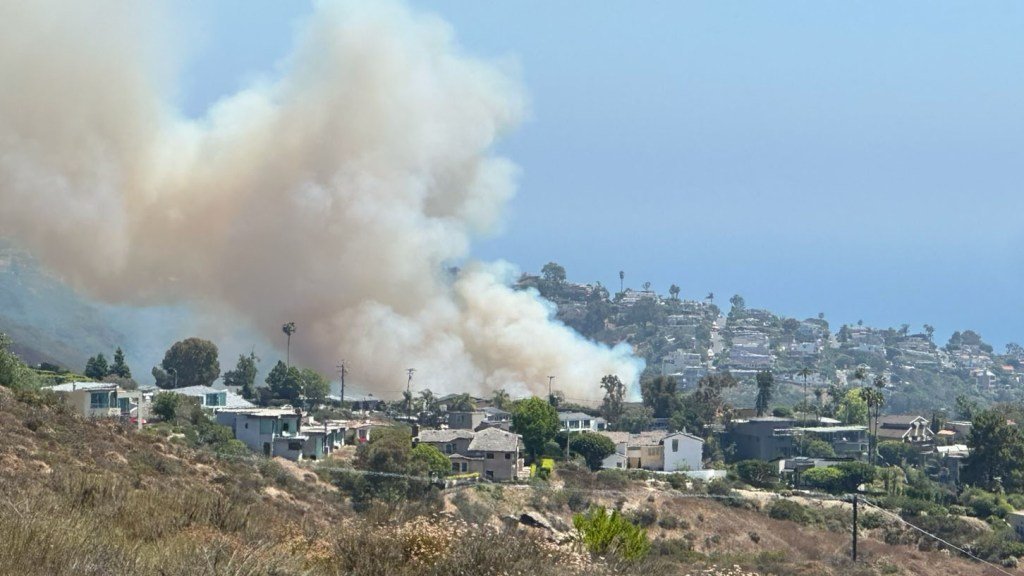Understanding the Rancho Fire: An Eruption in Laguna Beach
The air hung heavy with the acrid smell of smoke, a haunting reminder of nature’s unpredictable fury, as the residents of Laguna Beach looked over the horizon. What began as a flicker of flames swiftly escalated into the sprawling Rancho Fire, engulfing homes and altering lives forever. Amid the picturesque backdrop of sun-drenched cliffs and azure ocean, this inferno has not only threatened local ecosystems but also raised pressing questions about wildfire management and community resilience in an era of climate change.
The Emergence of the Rancho Fire
On a seemingly tranquil afternoon, a single spark ignited a series of events that would disrupt the lives of many. The Rancho Fire broke out on July 8, 2025, and within hours, the idyllic locale transformed into a battlefield against nature’s rage. Eyewitnesses reported seeing flames leap higher than the treetops, illuminating the night sky with a glowing orange hue. Local fire departments mobilized, but the fire’s rapid rate of spread overwhelmed initial efforts.
Fire Chief Marissa Thompson stated, “We were prepared for a busy season, but this fire’s onset was unlike anything we had anticipated. It’s a stark reminder that we must constantly adapt to the volatile nature of wildfires.”
The Factors at Play
Wildfires are complex phenomena influenced by various environmental factors. According to Dr. Evelyn Ortega, a climate scientist specializing in wildfire dynamics, “Increased temperatures and prolonged drought conditions create a perfect storm for fires like the Rancho Fire. The vegetation becomes a tinderbox, ready to ignite at any random spark.”
The following elements contribute significantly to wildfire outbreaks:
- Climate Change: Rising temperatures and erratic weather patterns exacerbate conditions conducive to wildfires.
- Human Activity: Campfires, discarded cigarettes, and downed power lines can trigger catastrophic blazes.
- Vegetation Management: Lack of proper brush clearance increases the fuel load, making fires more difficult to control.
In a recent study conducted by the University of California, researchers found that nearly 74% of wildfires in California are directly linked to climate change, reinforcing the urgent need for sustainable practices and proactive measures.
The Impact on Laguna Beach
With the fire spreading rapidly, mandatory evacuations were ordered for over 1,500 residents. The picturesque town, known for its artistic community and stunning landscapes, suddenly faced destruction. Historian Elena Gomez remarked, “Laguna Beach is not just a place; it’s a living testament to the blend of nature, art, and community spirit. Watching it threatened by wildfire is gut-wrenching.”
In the chaos, local shelters sprang to action. The Laguna Beach Community Center welcomed evacuees with open arms, providing necessities like food, clothing, and emotional support. Volunteer coordinator Jake Nguyen noted, “The community has come together like never before. It’s been inspiring to see people from all walks of life rallying for a common cause.”
The Role of Government and Agencies
Rapid response measures from state and local agencies influenced the course of the fire’s impact. However, critics argue that insufficient funding and resources hindered their efforts. As federal funding for fire management remains a contentious issue, experts warn that the consequences could be dire. Environmental policy analyst Dr. Rachel Lin assessed the situation: “Our government needs to prioritize wildfire management in its budget allocations. Ignoring this crisis will only lead to further catastrophes.”
Some key measures taken include:
- Increased Firefighter Resources: Additional personnel and equipment have been deployed to combat the blaze.
- Public Awareness Campaigns: Local governments have initiated programs to educate residents about creating defensible space and fire safety.
- Long-term Planning: Community engagement in urban planning and vegetation management is being emphasized to mitigate future risks.
Lessons Learned and Future Security
As the Rancho Fire continues to blaze, it has illuminated gaps in current wildfire management strategies. While the immediate response has been commendable, the plight of Laguna Beach serves as a chilling reminder that preparation must extend beyond emergency responses. Dr. Ortega stresses the importance of long-term strategies: “Incorporating climate resilience into urban planning and local policies is crucial. We need a proactive approach, focusing not just on suppression but on prevention.”
The aftermath of such events often leads to community dialogues. Town hall meetings are being scheduled to discuss restoration efforts, and how Laguna Beach can fortify itself against future calamities. In those discussions, residents voice their fears, hopes, and determination to preserve their community.
“It’s not just about rebuilding,” Jake reflected. “It’s about ensuring our community is more resilient, that we learn from this and adapt to face the future together.”
In a town that draws millions for its natural beauty, the flames of the Rancho Fire sparked not only fear but solidarity, urging residents and officials alike to rethink their relationship with nature. The coastline may have reclaimed its peaceful demeanor, but the scars of this fire will linger in the collective memory of Laguna Beach for years to come, reminding us that resilience is born from the ashes of adversity.









